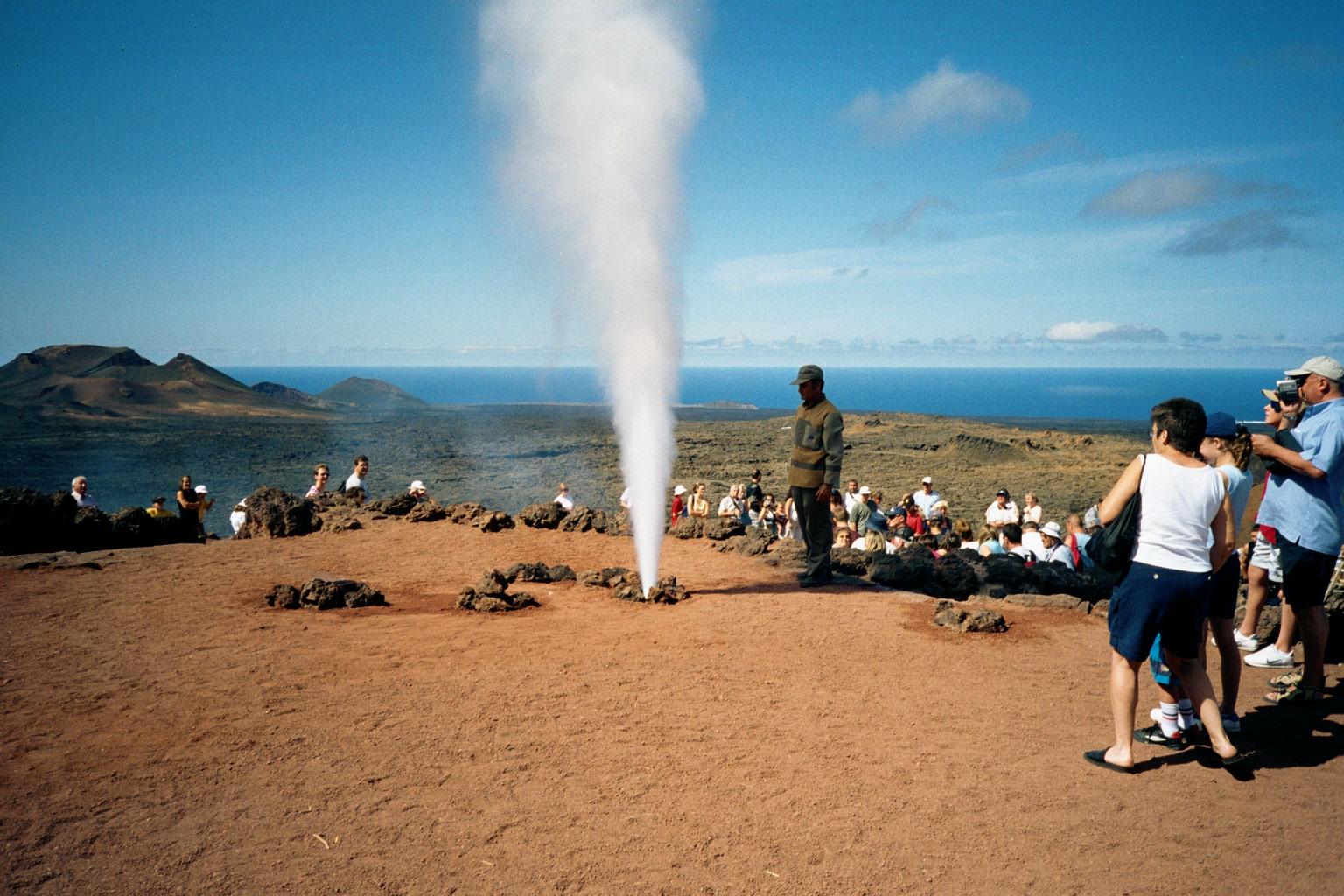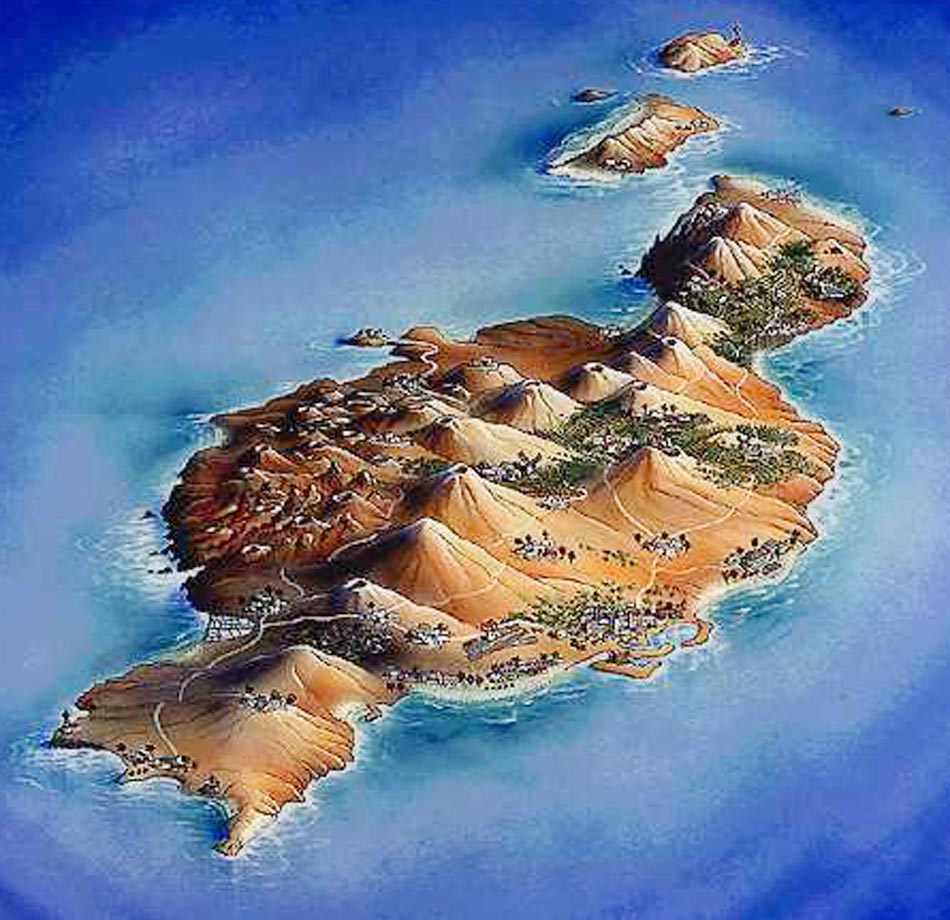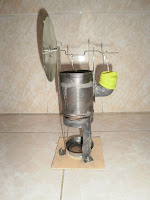Subsituting the ceramic flywheel for one CD and the iron crankshaft for other in aluminum, we get around 4 turns each once we turn the flywheel. We have reduced the weight around a ten percent of the initial, nevertheless this is insufficent. The displacer just weight 30 grams and in my opinion this is light.
 One characteristic happens with our engine that last 6 minutes in to get the optimal temperatures cold and hot in the respectives sides results in a very low output in the diaphragm piston ( the balloon) in comparison with the usual SFA engineFor to respond what occurs and why we made the simple experiment with a clay cylinder and a balloon. At beginning the imaginable and trivial state is showed in the left.
One characteristic happens with our engine that last 6 minutes in to get the optimal temperatures cold and hot in the respectives sides results in a very low output in the diaphragm piston ( the balloon) in comparison with the usual SFA engineFor to respond what occurs and why we made the simple experiment with a clay cylinder and a balloon. At beginning the imaginable and trivial state is showed in the left.Let's go to heat the device then, in a simple burner with gas...
After 4 minutes we obtain the following result. Apparently good, but the troubles go after.
By the way, doing this experiment with a glass tube used in laboratory is easy to break the glass with the increase of pressure. However with the clay doesn't happen this, and the thickness of the cylinder is of 2 mm. In this case we have a good fired piece of clay. Other thing not less important is that the glass tube increase its temperature in the fire in only a half minute, much more faster than the clay.
And here is where due to the bad transmission of the heat in the clay is a trouble, Retiring the cylinder of the fire, two minutes later, the ballon continuing inflated, ¿?, the clay once time heated is very difficult of to cold quickly by itself. And it is useless to retiring the balloon of the cylinder and fit in again for to heat the cylinder, the balloon doesn't inflate. The clay already is hot and the effect of heat with the burner is too low.
Conclusion: My theory is that in a Stirling engine the cold and hot sides doesn't be of clay. The same for the mobile pieces, almost we intend to create light pieces, easily breaking, with a scales near to us for to control the weight in all the moment. Another problem maybe could be that the wall of the cylinder are so thickness and disperse the heat¿?.
A video from Youtube of a machine with a glass cylinder. Very curious!!!
Another video
According to our experiments and viewing having in mind that, glass have a major thermal conductivity than the clay, ( glass, 1 W/(m·K) ; clay 0.34 W/(m·K)). So it's better to do a diplacer cylinder with glass than with clay for our domestic purposes. That's my conclusion for the moment.
According with a comment from a Germany's friend, there is a kind of mix between epoxi and concrete in the market. This could be useful because there is a chance of to do more thin pieces.
Links.
A comment about the ceramic motor by Wikipedia (in Spanish) here
Interesting links for to learn more about the ceramic technique.
http://pistonpumpss.com/2011/06/14/ceramic-cylinder/
http://www.ceramicrotaryengines.com/
http://www.ceralink.com/publications/PrecisionEpoxyCast_April03.PDF
http://www.faqs.org/patents/app/20080282693
http://www.google.com.tw/patents?id=Qz4FAAAAEBAJ&printsec=abstract&zoom=4#v=onepage&q&f=false
Commercial links for epoxy and concrete.
Discussions about ceramic technique for Stirling engine in Stirling Engine Forum.
Third Try.
After a long time ago trying to make a ceramic stirling engine, now my goal will be to start with a usual SFA stirling engine in metal. Step by step I'll substitute the pieces for ceramic items so I achieve a machine that runs and don't spend so much money because my goal is to build a different a cheap machine.
Lanzarote Stirling Project.
One chance for to generate great amounts of electricity from a stirling engine could be in Lanzarote, a small island in the Canary Islands archipelago.
 |
| A geyser in the island. |
 |
| Lanzarote map see in big size here. |
Lanzarote in wikipedia
The island have vulcanic backgrounds and a consequence of this is the opportunity of to get high temperatures a very short deeps in Timanfaya besides these points are very near of the ocean and a very low height above sea level. This means that we have a source of heat (around 600ºC) and cooling (sea water 20ºC). With this we can operate a very big stirling engine that provide electricity to the island and maybe the island could be self-sufficient with respect the fossil fuels for the electricity like in El Hierro, an island of the same archipelago obtains all the electricity needs by windmills and water reservoirs like batteries. The idea is to build a very big LTD engine (around 1.000.000 litres) in ceramic materials that respect the enviroment, ( the geysers are in natural park protected). The power output could be around 40MW.
Why and when use ceramic materials?
The main aim of to use ceramic materials is the price. Of course we can build a machine more fast in metal but another methods couldn't be forgot it. We can use glass, cement, concrete, clay, when these items can be get it free or a good price like a good alternative. However one thing we shouldn't forget with this. The ceramic materials have a low tractive effort, for this reason, is nonsense build machines of high temperature with thin walls because the material doesn't stand the high pressures. In the domestic machines we always attempt to create machines with thin walls for to save weight and minimize the inertia effect that have the ceramic materials, bad conductors of the heat.
Another point to remember is the quantity of heat that hold the material, glass is near 800ºC, the usual clay is around 1000ºC, concrete, epoxy and usual cement is 120ºC, refractory cement around 750ºC and so a large etc.
And for high temperatures?, I suppose we could work with refractory materials that stand 3000ºC and with large and fat walls for to the high pressures. Also will be important that the item hold the chock thermal by the back and forth of the air inside of the cylinder. In the market there a lot of clays that hold chock thermal and are refractory, all is a question of seek. Anyway if you think build a machine with these components, mind that is more easy to work a large scale (much more than domestic stirling engines) and for to get a temperature high (of 1000ºC for example) is needed a fire for several hours.
Curious Effect.
Beside of the metal engine that I'm working for to substitute for ceramic parts, there is another ceramic stirling engine doesn't work and I tried to improved by adding more weight at the flywheel and decreasing the dead space.
 |
| A thin film of epoxy for a better finish. |
 |
| Filling with cement and some of glue |
I belitle the dead space filing the power cylinder with cement and some of glue and I added another flywheel, the black ( of 375grms) that join with the ceramic flywheel ( 200grms) allows the machine runs 12 turns when it push one of the flywheels.
The result with a strong fire and icing water was very low and the machine doesn't run again as you can see in the video.
However you can see in the next video where we don't provide any heating and any cooling previously like the machine swell and deflate the balloon. That suggests me that this material could be a good result with LTD engines of low temperature but this is not my aim for the moment.






